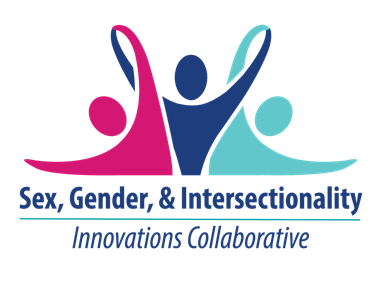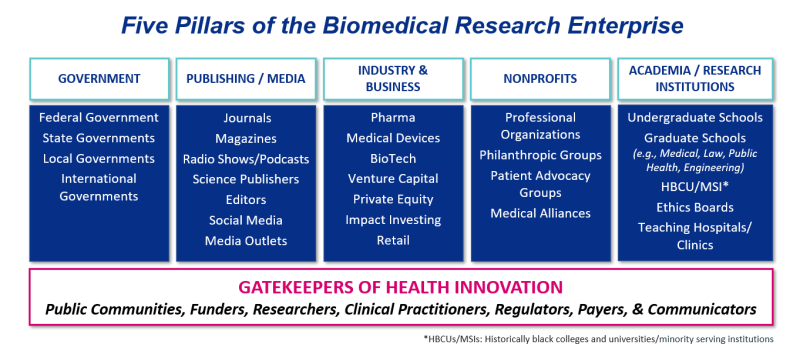About the Collaborative

The Sex, Gender, and Intersectionality (SG&I) Innovations Collaborative is an initiative that aims to illuminate research gaps and unmet health needs related to a limited focus on and understanding of sex[1], gender[2], and intersectionality[3] across health research, clinical practice, and the biomedical enterprise. The SG&I Innovations Collaborative seeks to highlight the scientific, societal, and economic opportunities created by these gaps and to catalyze innovation—accelerating progress toward gender health equity[4] globally.
Abundant evidence has demonstrated the importance of sex and gender as factors in understanding health and disease risk.[5], [6] Recent research has also highlighted the importance of intersectionality as a factor—recognizing that a person’s health status is influenced by the culmination of and intersections between that person’s lived experience and their multiple domains of identity (such as gender identity, generation, race, and ethnicity).[7], [8] However, the influences of sex, gender, and intersectional factors in health and disease remain underexplored areas of research and innovation, contributing to gaps in health research, technology, and care.
History and Background
The concept of the SG&I Innovations Collaborative arose out of the 5th Annual Vivian W. Pinn Symposium in May 2021, titled “Integrating Sex and Gender into Biomedical Research as a Path for Better Science and Innovation.” The event brought together thought leaders with expertise from different sectors—including government, publishing, industry, the nonprofit sector, and academia—and demonstrated both the power of partnerships and the need for better coordination and collaboration to drive innovation.
Mission, Vision, and Goals
The SG&I Innovations Collaborative aims to build and sustain connections across sectors and countries and create a space for partnership and collaboration among experts, researchers, advocates, health care and business professionals, and members of the public. Similar to a think tank, the collaborative seeks to galvanize a strong, diverse network and create a platform that serves to generate conversations and stimulate innovative approaches to advancing gender health equity globally.
The collaborative will work toward a future in which an understanding of sex, gender, and intersectionality (SG&I) is applied consistently across the global biomedical research enterprise and is reflected in the practices, priorities, and workforces across sectors. As the biomedical community continues to move toward a precision medicine[9] approach to care and treatment, the collaborative will leverage this opportunity to emphasize the importance of SG&I considerations in health and disease. In addition, it will promote the consideration of sex and gender as a core component of the precision health model. Ultimately, the collaborative aims to help lay a foundation for a world in which all people receive high-quality, evidence-based personalized care that is more convenient, cost-effective, and equitable.
Vision: Achieve gender health equity by advancing science and innovation to improve health and society for all.
Mission: Turn discovery into innovation and health by working across sectors and countries to integrate sex, gender, and intersectionality considerations throughout the biomedical research continuum and scientific enterprise—for rigorous, applicable, and open science worldwide.
Goals
- Develop strategies and approaches to advance the integration of sex, gender, and intersectionality (SG&I) considerations throughout the global biomedical research enterprise and workforce.
- Create a cross-sector and multinational network to drive innovation by building bridges and partnerships among (but not limited to) individuals from government, publishing/media, industry and business, the nonprofit sector, academia, and research institutions.
- Promote interdisciplinary collaboration and coordination to enhance translational and implementation research that cultivates gender health equity internationally.
- Serve as a publicly accessible resource, harnessing the power of shared knowledge and diverse perspectives—disseminating stories, data, research, and lessons learned.
The Five Pillars
The Five Pillars and Gatekeepers of Health Innovation represent a framework capturing key stakeholders across the biomedical enterprise. The collaborative seeks to leverage the individual strengths of each pillar and their collective strengths to drive systemic change. For more information, please see the collaborative’s LinkedIn page, which will serve as a primary platform for communication.
Alignment of the SG&I Innovations Collaborative
The SG&I Innovations Collaborative aligns with many of the objectives set forth in the National Strategy on Gender Equity and Equality, which highlights the importance of ensuring that women are afforded equal opportunities in employment, education and access to health care, as well as closing gender gaps and encouraging innovation and entrepreneurship in science, technology, engineering, mathematics, and medicine (STEMM). In addition, the mission and goals align closely with the guiding principles and objectives laid out in the 2019–2023 Trans-NIH Strategic Plan for Women’s Health Research and the 2021–2025 NIH-Wide Strategic Plan, which both speak to the importance of leveraging strategic partnerships, promoting collaboration across the public and private sectors, and developing innovative approaches to advance health equity.
Reference AnchorReferences
Sex is a multidimensional biological construct based on anatomy, physiology, genetics, and hormones. (These components are sometimes referred to together as “sex traits.”) Sex is usually categorized as male or female, but variations occur. These variations in sex characteristics are also called intersex conditions. Adapted from NASEM, 2022.
Gender is a multidimensional construct that encompasses gender identity and expression, as well as social and cultural expectations about status, characteristics, and behavior as they are associated with certain sex traits. (Adapted from NASEM, 2022.) As a social construct, gender is influenced by social, cultural, environmental, and behavioral factors. Diversity exists in how individuals and groups express, understand, and experience gender.
“Intersectionality” refers to the culmination of a person’s multiple domains of identity (e.g., gender identity, race/ethnicity, generation, and sexual orientation) combined with their lived experience. It influences health status and disease risk throughout the life course.
Gender health equity is the state in which everyone has a fair and just opportunity to attain their highest level of health, in particular as it relates to a person's gender and other intersectional social factors. See CDC’s “What is Health Equity?”
White, J., Tannenbaum, C., Klinge, I., Schiebinger, L., Clayton, J. (2021). The Integration of Sex and Gender Considerations Into Biomedical Research: Lessons From International Funding Agencies. The Journal of Clinical Endocrinology & Metabolism, 106(10) 3034–3048, https://doi.org/10.1210/clinem/dgab434
Arnegard ME, Whitten LA, Hunter C, Clayton JA. (2020). Sex as a Biological Variable: A 5-Year Progress Report and Call to Action. J Womens Health (Larchmt), 29(6):858-864. doi: 10.1089/jwh.2019.8247.
White, J., & Clayton J. (2022). The gender health innovation gap: A perspective from the NIH Office of Research on Women’s Health. Med, 3(5), 298–301. https://doi.org/10.1016/j.medj.2022.04.010
Schiebinger, L. (2022). Sex, gender, and intersectional puzzles in health and biomedicine research. Med, 3(5), 284-287. https://doi.org/10.1016/j.medj.2022.04.003.
“Precision medicine is an approach to disease treatment and prevention that seeks to maximize effectiveness by taking into account individual variability in genes, environment, and lifestyle. Precision medicine seeks to redefine our understanding of disease onset and progression, treatment response, and health outcomes through the more precise measurement of molecular, environmental, and behavioral factors that contribute to health and disease.” Precision Medicine Initiative (PMI) Working Group Report to the Advisory Committee to the Director, NIH. (2015). “The Precision Medicine Initiative Cohort Program – Building a Research Foundation for 21st Century Medicine.” https://www.nih.gov/sites/default/files/research-training/initiatives/pmi/pmi-working-group-report-20150917-2.pdf


